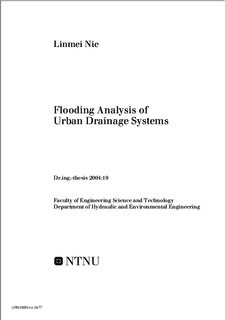| dc.description.abstract | - Description of the problems
Throughout history floods have been one of the most severe natural catastrophes, which brought about loss of lives and huge economic losses in addition to the influence on community activities and adverse effects on the environment. We have witnessed enormous flood events almost all over the world, even in the early years of 21st century. The cruel lesson learnt is that we have not coped well with floods.
Studying the risk of flooding is the goal of this thesis. The focus is given to flooding of urban drainage systems. Urban climate, human activities and land use vary quickly and greatly with time. These variations modify the features of both urban hydrology and hydraulics, and change the distribution of water. It may lead to dual adverse effects in one region: the severe water shortage in one period and the increasing risk of flooding in another period. Therefore, finding appropriate solutions for these problems has been being a great challenge for the whole world.
- Aims of this study
This study aims to contribute ideal approaches and models to understand deeply urban flooding problems, i.e. to find the causes of flooding, to analyze their propagations and on this basis to evaluate the risk of flooding, and finally to search for solutions for flood mitigation.
- Study contents and methodologies
Distinguishing the potential hazards of urban flooding, delineating the changes of urban lands, developing models to simulate flooding and examining different measures to mitigate the risk of flooding constitute the main contents of this study. It is carried out by both qualitative analysis and quantitative simulations in a stepwise manner. Regarding the stochastic characteristics of flooding, a risk analysis initiates the study, which aims to formulate flooding scenarios in general urban environment through procedures of system definition, hazard identification, causal analysis, frequency analysis, consequence estimation and mitigation. A Norwegian case study illustrates the whole process.
Following the risk analysis, GIS technology is introduced to delineate the variation of topography. GIS hydrological modeling is applied to delineate the basic hydrological elements from a Digital Elevation Model (DEM). The accuracy of grid DEM and the influence of buildings are studied.
Two urban flooding models, the "basin" model and the dual drainage model, are developed on the basis of the MOUSE program (DHI, 2000). The three models, i.e. the MOUSE model, the “basin” model and the dual drainage model, are examined through two case studies, and the flow capacities of the existing sewers in these two case studies are then checked. Following the flooding simulation, the effectiveness of four flooding mitigation measures is tested.
- Main results
Sixty-eight (68) potential flooding hazards are identified by risk analysis in Chapter three. In combination with Trondheim case study, the frequencies of several flooding scenarios are studied, and it is indicated that the flooding of urban drainage systems happens more frequently than river flooding. When it happens, urban flooding disturbs very much the activities in flooding areas. Therefore management attentions should be paid to urban flooding in addition to large river flooding.
GIS is used as a bridge between digital data and numerical flooding simulation. Two important hydrological elements, watersheds and surface stream networks, are derived from grid DEM in Chapter four. The preliminary flood risk zones are delineated in combination with two case studies. They provide useful information for flood management.
The three flooding models are calibrated through two case studies: Trondheim- Fredlybekken catchment in Norway and Beijing-Baiwanzhuang (BWZ) catchment in China. Flooding checking of the existing sewer systems in these two case studies indicates that the current flow capacities of sewers are less than the designed capacities. Consequently, flood mitigation measures are examined in the following Chapter six. The study indicates that the combination of structural and non-structural flood mitigation measures are regarded as the comprehensive solution for flood control.
- Restrictions of the developed models
The developed flood models are restricted to summer and autumn flooding situations. In other words, the snowmelt routine is not included in the hydrological model applied. However, if a hydrological model that is able to simulate snowmelt could be connected to the developed models, then the hydraulic analysis would be carried out similarly. | nb_NO |
